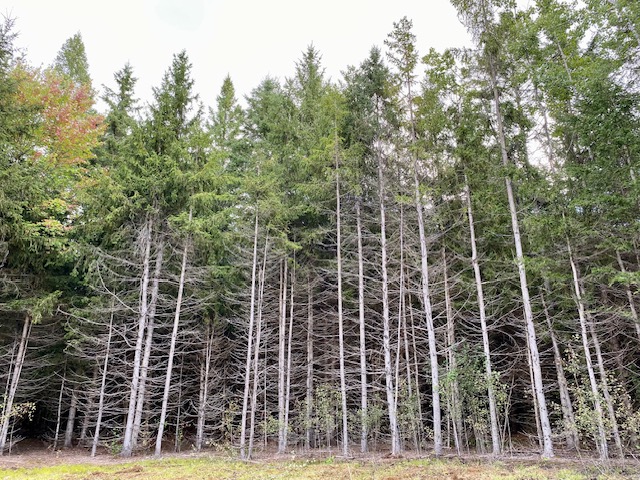
Features
Opinions
Opinion: Deforestation in Canada and other fake news
January 25, 2024 By John Mullinder
 Photo: Annex Business Media.
Photo: Annex Business Media. As the author of a book on deforestation in Canada, I feel I have some qualification to comment on recent claims made by an alliance of environmental groups that the federal government is “spinning” the truth on the subject.
Unfortunately, there is widespread public (and media) confusion about what deforestation is and isn’t. From a dictionary point of view, it would be easy to conclude that deforestation is simply about removing trees, and that reforestation is about growing them back again. That’s what the commonly displayed images all show: a stark clear-cut, or a young green spruce stretching skyward.
But for people whose job it is to track deforestation and to do something about it, it’s a lot more complicated than that. The world’s forest scientists through the United Nations make a key distinction when it comes to removing trees from forest land. When trees are removed and replaced by agricultural crops, grazing land, residential subdivisions, or flooded to make hydro reservoirs, the forest is unlikely to come back to forest. That is called deforestation.
But if that forest land is regenerated as forest – either naturally or artificially through tree planting or direct seeding – then that is not considered to be deforestation. The land remains forest land where trees will be grown again. Logging by itself, then, is not deforestation. Only if the land is not returned to forest.
Advertisement
This is not an “industry” definition nor a “Canadian” one. It is how 236 nations report data to the United Nations so that global and individual country rates of deforestation can be uniformly tracked, assessments made, and remedial action taken. Canada has one of the lowest rates in the world (0.01 per cent).
The major cause in this country (almost half of it) is the conversion of forest land to agriculture, followed by mining, oil and gas exploration, and what’s called “built-up” (industrial/commercial and municipal development including residential subdivisions). Forestry’s specific contribution is minimal (two per cent), mainly through the creation of permanent forest access roads.
This national and global tracking exercise includes guidelines on how countries should measure deforestation. And environmental groups can legitimately point to an instance where some logging scars in part of Ontario have not sufficiently reverted to forest over many years. For that failure, the land owner, the province, is clearly responsible.
The logging scars in question arise from what are called landing areas where full trees are sometimes dragged from the stump to the roadside so that merchantable logs can be separated from the waste wood. But forestry experts say that extrapolating estimates from 27 study sites in one region to the total harvest area of Ontario is problematic.
That’s because most of these study sites were harvested using full-tree harvesting two or even three decades ago when stroke de-limbers first came into use. Today, waste wood (tops and branches) is piled and burned instead, or chipped for pulp and energy in a nearby mill. It should also be noted that not all harvested areas in Ontario are forests that have never been harvested before. The forest losses claimed in the study, then, should not be extrapolated to the whole of Ontario, and especially not to those areas that already have an existing road network.
There’s a reason why these landing areas are not included in Ontario’s deforestation estimates in the first place. They are on forest land, and deforestation technically occurs only when forest land is converted to non-forest land. They are also small areas, and Canada follows the Intergovernmental Panel on Climate Change guidelines on measuring these too.
Any small “change events” (less than one hectare in size, such as landings) are to be excluded from deforestation estimates. A few smaller European countries have chosen to adopt smaller minimal areas (0.5 hectare) but this level of detail is just not economically or practically feasible in a country the size of Canada. This exclusion of small areas works both ways, however. If new forest is added, but the area is not large enough to meet the guidelines, it too is excluded from the estimates.
Even if the assumptions about the Ontario landing scars in question were valid and included in the current deforestation estimates, and could be extrapolated nationally, preliminary research indicates that Canada’s overall annual rate would still be less than half of one per cent (0.4 per cent). That doesn’t let Canadians off the hook. Canadians share responsibility for the major causes of global deforestation: consuming palm oil, soy, and cattle and wood products provided by supply chains linked to deforestation in other (mainly tropical) countries. We can, and should be doing a lot more about that.
John Mullinder is the author of Little Green Lies and Other BS: From “Ancient” Forests to “Zero” Waste, and Deforestation in Canada and Other Fake News. A former TV reporter in his native New Zealand and foreign correspondent for Maclean’s magazine and the Financial Post, Mullinder ran Canada’s Paper & Paperboard Packaging Environmental Council (PPEC) for 30 years, achieving a number of North American firsts in waste reduction and recycling. www.johnmullinder.ca
Print this page